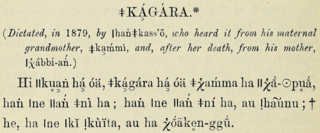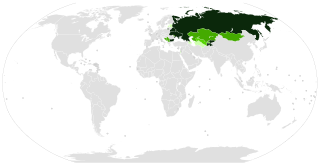
A diacritic is a glyph added to a letter or to a basic glyph. The term derives from the Ancient Greek διακριτικός, from διακρίνω. The word diacritic is a noun, though it is sometimes used in an attributive sense, whereas diacritical is only an adjective. Some diacritics, such as the acute ⟨á⟩, grave ⟨à⟩, and circumflex ⟨â⟩, are often called accents. Diacritics may appear above or below a letter or in some other position such as within the letter or between two letters.

Latin phonology continually evolved over the centuries, making it difficult for speakers in one era to know how Latin was spoken before then. A given phoneme may be represented by different letters in different periods. This article deals primarily with modern scholarship's best reconstruction of Classical Latin's phonemes (phonology) and the pronunciation and spelling used by educated people in the late Roman Republic. This article then touches upon later changes and other variants. Knowledge of how Latin was pronounced comes from Roman grammar books, common misspellings by Romans, transcriptions into other ancient languages, and from how pronunciation has evolved in derived Romance languages.
A macron is a diacritical mark: it is a straight bar ¯ placed above a letter, usually a vowel. Its name derives from Ancient Greek μακρόν (makrón) 'long' because it was originally used to mark long or heavy syllables in Greco-Roman metrics. It now more often marks a long vowel. In the International Phonetic Alphabet, the macron is used to indicate a mid-tone; the sign for a long vowel is instead a modified triangular colon ⟨ː⟩.

The Standard Alphabet is a Latin-script alphabet developed by Karl Richard Lepsius. Lepsius initially used it to transcribe Egyptian hieroglyphs in his Denkmäler aus Ägypten und Äthiopien and extended it to write African languages, published in 1853, 1854 and 1855, and in a revised edition in 1863. The alphabet was comprehensive but was not used much as it contained a lot of diacritic marks and was difficult to read and typeset at that time. It was, however, influential in later projects such as Ellis's Paleotype, and diacritics such as the acute accent for palatalization, under-dot for retroflex, underline for Arabic emphatics, and the click letters continue in modern use.
The Germanic umlaut is a type of linguistic umlaut in which a back vowel changes to the associated front vowel (fronting) or a front vowel becomes closer to (raising) when the following syllable contains, , or.
German orthography is the orthography used in writing the German language, which is largely phonemic. However, it shows many instances of spellings that are historic or analogous to other spellings rather than phonemic. The pronunciation of almost every word can be derived from its spelling once the spelling rules are known, but the opposite is not generally the case.

Marshallese, also known as Ebon, is a Micronesian language spoken in the Marshall Islands. Spoken by the ethnic Marshallese people, the language is spoken by nearly the country's entire population of 59,000, making it the principal language of the country. There are also roughly 27,000 Marshallese citizens residing in the United States, nearly all of whom speak Marshallese, as well as in other countries including Nauru and Kiribati.
Old English phonology is necessarily somewhat speculative since Old English is preserved only as a written language. Nevertheless, there is a very large corpus of the language, and the orthography apparently indicates phonological alternations quite faithfully, so it is not difficult to draw certain conclusions about the nature of Old English phonology.
The phonological system of the Polish language is similar in many ways to those of other Slavic languages, although there are some characteristic features found in only a few other languages of the family, such as contrasting postalveolar and alveolo-palatal fricatives and affricates. The vowel system is relatively simple, with just six oral monophthongs and arguably two nasals in traditional speech, while the consonant system is much more complex.
Like many other languages, English has wide variation in pronunciation, both historically and from dialect to dialect. In general, however, the regional dialects of English share a largely similar phonological system. Among other things, most dialects have vowel reduction in unstressed syllables and a complex set of phonological features that distinguish fortis and lenis consonants.
Proto-Samoyedic, or Proto-Samoyed, is the reconstructed ancestral language of the Samoyedic languages: Nenets, Enets, Nganasan, Selkup, as well as extinct Kamas and Mator. Samoyedic is one of the principal branches of the Uralic language family, and its ancestor is Proto-Uralic. It has been suggested that Proto-Samoyedic greatly influenced the development of Tocharian, an Indo-European language.

Numerous Cyrillic alphabets are based on the Cyrillic script. The early Cyrillic alphabet was developed in the 9th century AD and replaced the earlier Glagolitic script developed by the Byzantine theologians Cyril and Methodius. It is the basis of alphabets used in various languages, past and present, Slavic origin, and non-Slavic languages influenced by Russian. As of 2011, around 252 million people in Eurasia use it as the official alphabet for their national languages. About half of them are in Russia. Cyrillic is one of the most-used writing systems in the world. The creator is Saint Clement of Ohrid from the Preslav literary school in the First Bulgarian Empire.
The Cyrillic script family contains many specially treated two-letter combinations, or digraphs, but few of these are used in Slavic languages. In a few alphabets, trigraphs and even the occasional tetragraph or pentagraph are used.

Proto-Tocharian, also spelled Proto-Tokharian, is the reconstructed proto-language of the extinct Tocharian branch of the Indo-European languages.
Gwari is a Nupoid language spoken by the Gbagyi people, which make up over a million people in Nigeria. There are two principal varieties, Gbari and Gbagyi, which have some difficulty in communication; sociolinguistically they are distinct languages.
The phonology of Old Saxon mirrors that of the other ancient Germanic languages, and also, to a lesser extent, that of modern West Germanic languages such as English, Dutch, Frisian, German, and Low German.
As a member of the dialect continuum of Romance languages, Catalan displays linguistic features similar to those of its closest neighbors. The following features represent in some cases unique changes in the evolution of Catalan from Vulgar Latin; other features are common in other Romance-speaking areas.
Comparative work of the Afroasiatic languages uses a semi-conventionalized set of symbols that are somewhat different than the International Phonetic Alphabet and other phonetic notations. The more salient differences include the letters ⟨c, ʒ⟩ for IPA, the circumflex diacritic ⟨◌̂⟩ for lateral obstruents, and the sub-dot ⟨◌̣⟩ for emphatic consonants, which depending on the language may be ejective, implosive or pharyngealized.








